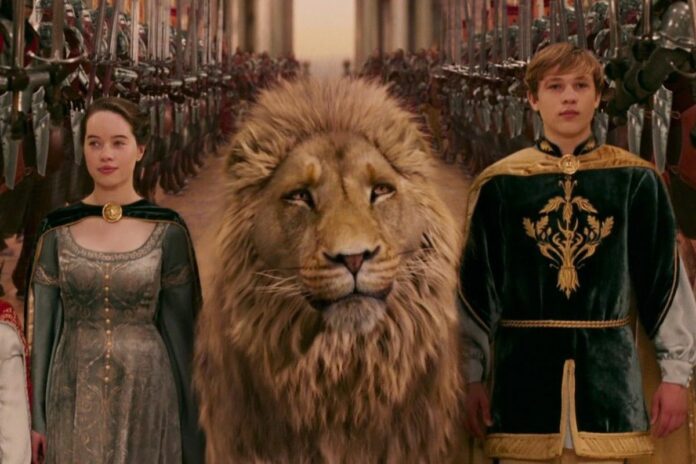Did you know that The Chronicles of Narnia has sold over 100 million copies worldwide? This beloved series by C.S. Lewis has captivated readers for generations with its enchanting world, unforgettable characters, and timeless themes.
C.S. Lewis’s The Chronicles of Narnia series has enthralled readers for decades. With its rich storytelling and memorable characters, it’s no wonder these books have become a cornerstone of children’s literature. Here are some fascinating facts about this beloved series.
- Seven Books in Total: The Chronicles of Narnia consists of seven books, beginning with The Lion, the Witch and the Wardrobe and concluding with The Last Battle.
- Published Between 1950 and 1956: The series was released over six years, with each book adding new layers to the magical world of Narnia.
- Inspired by a Picture: C.S. Lewis was inspired to write the series by a mental image of a faun carrying an umbrella in a snowy forest.
- Christian Allegory: Many readers interpret the series as a Christian allegory, with Aslan the lion symbolizing Jesus Christ.
- Over 100 Million Copies Sold: The series has sold over 100 million copies worldwide, making it one of the best-selling book series of all time.
- Translated into 47 Languages: The Chronicles of Narnia has been translated into 47 different languages, allowing readers around the globe to experience the adventures.
- Narnia’s Creation: Narnia was brought into existence by Aslan’s song in The Magician’s Nephew, the sixth book in the series but a prequel to the first.
- Talking Animals: Narnia is home to many talking animals, including the courageous mouse Reepicheep and the wise Mr. and Mrs. Beaver.
- Time Works Differently: Time in Narnia moves differently than in our world—what may seem like a few minutes here can translate to years in Narnia.
- Four Pevensie Siblings: The main characters in the first book are the Pevensie siblings: Peter, Susan, Edmund, and Lucy.
- The White Witch: Jadis, the White Witch, is the main antagonist in The Lion, the Witch and the Wardrobe, casting a spell over Narnia that makes it always winter but never Christmas.
- The Wardrobe: The magical wardrobe that leads to Narnia was made from the wood of a tree grown from a seed of the apple that Digory Kirke brought back from Narnia in The Magician’s Nephew.
- C.S. Lewis and J.R.R. Tolkien: C.S. Lewis was a close friend of J.R.R. Tolkien, the author of The Lord of the Rings. They were both members of a literary discussion group called the Inklings.
- Illustrations by Pauline Baynes: The original illustrations for the series were done by Pauline Baynes, whose artwork has become iconic.
- Lewis’s Reluctance: Initially, C.S. Lewis was hesitant to write children’s books, but he was persuaded by his friends and his own love for fairy tales.
- Influence of World War II: The evacuation of children during World War II influenced the plot of The Lion, the Witch and the Wardrobe, where the Pevensie children are sent to the countryside.
- Dedicated to Lucy Barfield: The Lion, the Witch and the Wardrobe was dedicated to Lucy Barfield, the daughter of Lewis’s close friend Owen Barfield.
- Adaptations: The series has been adapted into various formats, including radio plays, television series, stage plays, and major motion pictures.
- Aslan the Lion: Aslan, the great lion, is the true king of Narnia and appears in all seven books.
- Prince Caspian: Prince Caspian, the rightful heir to the Narnian throne, is the main character in the second book, Prince Caspian.
- Reepicheep the Mouse: Reepicheep, the valiant mouse, is known for his bravery and loyalty.
- Mr. Tumnus: Mr. Tumnus, the faun, is the first creature Lucy meets in Narnia.
- Puddleglum the Marsh-wiggle: Puddleglum, a pessimistic but brave marsh-wiggle, plays a significant role in The Silver Chair.
- The Dufflepuds: The Dufflepuds are one-legged creatures who appear in The Voyage of the Dawn Treader.
- Influence on Other Works: The series has influenced many other works of fantasy literature, including J.K. Rowling’s Harry Potter series.
- Narnia Day: Some fans celebrate Narnia Day on October 16th, the date The Lion, the Witch and the Wardrobe was first published.
- Narnia in Pop Culture: References to Narnia can be found in various forms of pop culture, including TV shows, movies, and music.
- Educational Value: The series is often used in educational settings to teach themes of bravery, friendship, and morality.
- Fan Communities: There are numerous fan communities dedicated to discussing and celebrating The Chronicles of Narnia.
- C.S. Lewis’s Legacy: C.S. Lewis’s work on The Chronicles of Narnia has solidified his legacy as one of the greatest authors of children’s literature.
The Chronicles of Narnia series has captivated readers for decades. C.S. Lewis created a world brimming with magic, adventure, and profound lessons. From the majestic Aslan to the treacherous White Witch, each character adds richness to the story. The series explores themes of bravery, friendship, and sacrifice, making it more than just a children’s tale.
Narnia’s deep lore and captivating narratives continue to inspire new generations. Whether you’re revisiting these stories or discovering them for the first time, there’s always something new to uncover. The blend of fantasy and moral lessons ensures that The Chronicles of Narnia remains a cherished classic.
So, next time you open one of these books, remember the magic within its pages. Narnia isn’t just a place; it’s an experience that stays with you long after the book is closed.
